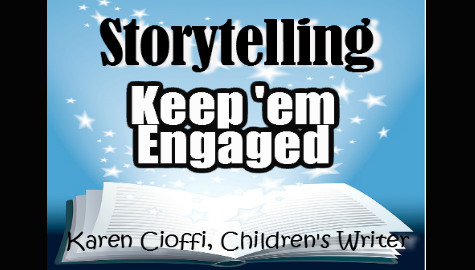As an author, it’s your job to create an engaging, compelling, suspenseful, intriguing, romantic, or other type of story content that will lure readers in and keep them turning the pages. But the key word for a successful story is ‘engaging.’
Engagement, according to Merriam-Webster.com, means to have an emotional involvement or commitment. Based on this, no matter what genre you write in the story must hold or engage the reader.
In an article in the Writer’s Digest January 2011 issue, Steven James takes a look at aspects of “great storytelling.”
The first rule of a successful story, according to James, is “cause and effect.” In children’s writing, this is the same as an obstacle and its solution: there must be a circumstance that leads the protagonist to take an action in an effort to solve the problem. I do like the wording James uses, though, because it’s more in line with multiple writing genres.
In its simplest form, something happens (the cause) that creates or motivate an action or reaction (the effect).
James goes on to explain that, along with cause-and-effect, the order in which an event unfolds or how it’s written will also determine whether the reader stays engaged or disengages.
“As a fiction writer, you want your reader to always be emotionally present in the story,” explains James. If the sequence of an event causes the reader to stop and wonder why something is happening, even if just for a moment, you’ve left room for disengagement.
As an example, suppose you write:
She fell to her knees, dropped her head, and wept uncontrollably. Her husband was dead.
While in just eleven words the reader does learns why the woman is crying, it could very well leave enough time for the reader to pause and wonder: Why did she fall to her knees?
This can lead to disengagement.
To create a cause-and-effect scenario that keeps the reader in the loop, you might write:
Her husband was dead; the words echoed through the room. She fell to her knees, dropped her head, and wept uncontrollably.
The second aspect of writing James touches upon is creating and maintaining a believable story. Even when writing fantasy or science fiction, consistency is needed, along with believable actions, reactions, observations, conclusions, and so on within the boundaries of the story.
A basic example of this might be if you write about a character with brown eyes, then, somewhere within the story, you accidentally mention that the eyes are blue. This little slip creates a believability gap.
Any gap in the believability of the story or its characters has the potential to cause the reader to pause, question, and very possibly become disengaged.
Watch for disengagement gaps so this doesn’t happen to you.
MORE ON WRITING FOR CHILDREN
Finding Age Appropriate Words When Writing For Children
Ingredients for a Perfect Picture Book
Plot and Your Story – Four Formats
I’m a working children’s ghostwriter, rewriter, and coach. I can help turn your story into a book you’ll be proud to be the author of, one that’s publishable and marketable.
OTHER HELP I OFFER:
HOW TO WRITE A CHILDREN’S FICTION BOOK
A DIY book to help you write your own children’s book.
FICTION WRITING FOR CHILDREN eCOURSE
4-Weeks / 8 Sections Guided Self-Study Program
WRITERS ON THE MOVE SELF-PUBLISHING SERVICE
Self-publishing help for children’s authors
(Picture books and chapter books)
You can contact me at kcioffiventrice@gmail.com.


